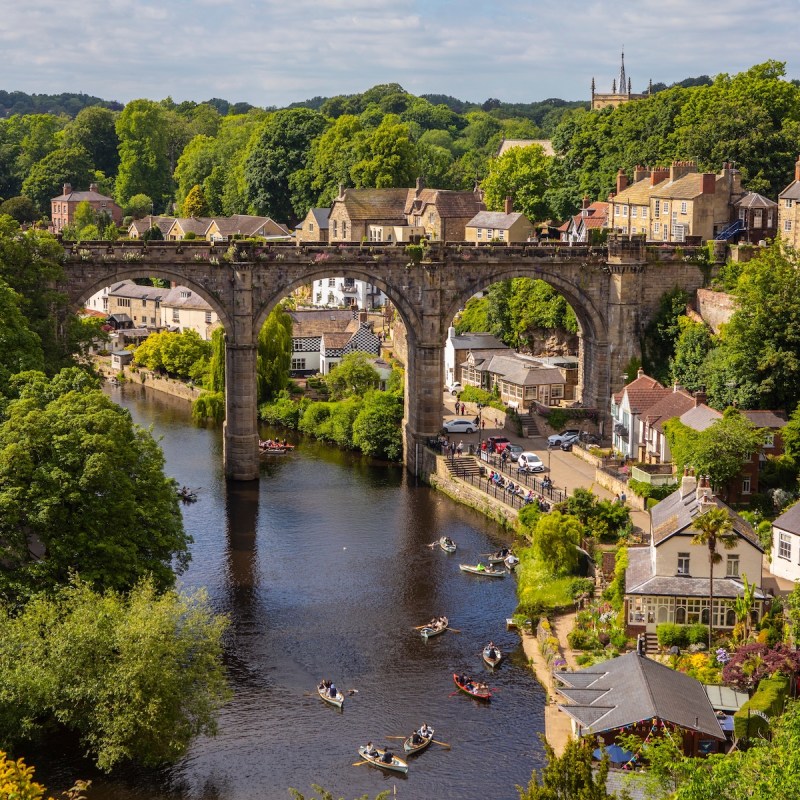
When I first moved to England, I don’t think I had ever even heard of Yorkshire. Then I met this guy at university, and long story short and 30-odd years later, I have now been to Yorkshire more often than any other part of the world. My in-laws still live there and we go and visit several times a year, never mind where in the world we happen to live.
Videos by TravelAwaits
Even though I first thought it rather bleak, cold, and too rugged to call it pretty, over the decades, I have taken Yorkshire into my heart and gotten to know some great historic sights and truly spectacular natural backdrops — such as Aysgarth Falls. I’ve walked an accumulated hundreds of miles across the Yorkshire Dales, visited lovey cities, and countless hamlets, villages, and small market towns — all of which are worth seeing and all of which tend to have a great little pub.
There are some really gorgeous and very charming market towns across the four counties of Yorkshire, which is comprised of York, West Yorkshire, East Riding, and North Yorkshire.
Here are some of my favorite little places, all of which I can highly recommend.

1. Richmond
Richmond is a picture-perfect market town in the Yorkshire Dales, complete with a Norman Castle dating to 1071. Here, you’ll see little cobbled streets, cutesy cottages nestled next to lovely Georgian architecture, and the largest cobblestone-paved marketplace in England. Every Wednesday and Saturday, the lovely market square fills with stalls and comes alive. But even when the market is not on, Richmond offers lovely shopping with plenty of small individual boutiques and so many cafes that you will have to stop off a few times. Afterward, pop into the Friary Gardens with their 15th-century bell tower, and the somewhat eclectic Richmondshire Museum, which holds exhibits ranging from the Stone Age to partial sets of the famous TV series All Creatures Great and Small.
Pro Tip: Have a look at what’s playing in the cinema when you are in Richmond. Since it is located in an old train station, you can also go for a lovely walk along the Swale River just behind it. The river winds its way through most of North Yorkshire, with forces and falls along its route.

2. Knaresborough
Knaresborough, with its arched viaduct across the Nidd River and its cafes by the riverside, is so charming, it hurts. Picture-perfect with its stone cottages, river reflections, cobbled lanes, and busy town center, this is a fabulous place to see that Yorkshire is anything but bleak. Records claim that friendly Knaresborough’s daily market has been going since 1206, making it the longest continually-run market in the entire country. A ruined fortress presides over the city, dating back to the 1100s. The Nidd offers great riverside walks in both directions, and you can continue walking along to Mother Shipton’s Cave, the hideaway of the UK’s most famous prophetess. If you are lucky, you’ll even see an old-fashioned steam train puff across the viaduct during your walk.
Pro Tip: For a lovely stay near the water, book yourself into Teardrop Cottage, with views of the viaduct, Nidd Gorge, and the castle.

3. Hawes
Hawes is one of my favorite little towns in the area because of its bustling main street and the gurgling Ure River hemmed by old stone cottages. Between the many tea shops offering very decent afternoon cream tea and hot teacakes — with good Yorkshire tea in a big pot — and the little antique shops, there is always something that follows me home. Market day here, England’s highest market town, is on Tuesdays when the main street fills with stalls. Once upon a time, not that long ago, the farmers brought their cows and sheep here. They then clogged up the streets, but now they have a dedicated auction hall a bit out of the way. Hawes is most famous for Wensleydale cheese. If you have ever watched Wallace and Gromit, the fabulously funny clay animation set in Yorkshire, you will have heard of Wensleydale cheese. If not, pop into the Wensleydale Creamery for a tasting.
Pro Tip: Should you miss the market, head to the Hawes Market House, where there is usually an indoor market, a concert, or exhibition of some sort happening.

4. Leyburn
This is the hometown of my in-laws. Not the prettiest, admittedly, but it is the largest market town in Wensleydale. People come to Leyburn from near and far for the Friday market, stocking up on foodstuffs and other goodies. Leyburn is a small town which even has a tiny tourism office, a couple of good supermarkets in the square, a decent fish and chip shop, and three or four pubs. There are even a couple of charity shops. One of which, St. Theresa’s Hospice, always has a great selection of second-hand books upstairs. Leyburn is a great base from where to explore nearby Middleham, with its castle which was the childhood home of King Richard III. You can also catch the Forbidden Corner, a quirky park filled with follies which delight old and young, and the lovely Bolton Castle. Plus, there are countless great walks which range from more challenging hill climbs to easier river walks.
Pro Tip: Whenever the guest bedroom of my in-laws is already occupied, I tend to stay at this gorgeous little cottage just off the market square. You get the entire property to yourself and are steps away from everything, yet in a quiet lane.

5. Whitby
Whitby is a charming town on the Esk River estuary by the North Sea. Famous for its fish and chips and Gothic Whitby Cathedral ruins on the cliffs opposite the town — which inspired Bram Stoker’s Dracula — this is also a market town with several options for good shopping. On various days of the week, weather permitting, you’ll find the local farmers market setting up outdoors on Market Square. While at Abbey Wharf, an indoor arts and crafts market takes place. On Sundays, you usually have additional stalls and car-boot sales in and around Whitby. But even without markets, Whitby is a great place to visit, with stunning beaches nearby, superb views from the old cathedral ruins, and a bustling town center — which gets very busy in summer and on weekends, and is best explored during the week.
Pro Tip: This is where to eat seriously good fish and chips, the traditional seaside food of England. The most famous restaurants are probably Trenchers of Whitby or Hadleys Fish Restaurant. Personally, I prefer to queue at Magpie Cafe and then take my food to a bench overlooking the sea and eat there, getting my fingers sticky.

6. York
York might not be a small market town, but it is definitely bursting with charm. York warrants inclusion in this list for its many different markets, ranging from antique markets, farmers markets, Christmas markets, and more. In the historic streets of the Shambles, a daily market takes place, selling everything from food to arts and crafts and great souvenirs. Just by the gorgeous York Minster, you’ll find the many antique stores. While on Parliament Street and St. Sampson’s Square, where the Christmas Market takes place during the holidays, you will find daily food trucks and stalls selling everything from fresh cinnamon donuts to grilled sausages and pies.
Pro Tip: When in York — or Harrogate or Northallerton — you will need to pop into Betty’s Tea Rooms for some great food, cakes, coffee, and tea. Betty’s is a Yorkshire institution, and nothing beats their cinnamon toast, scones with cream and jam, or toasted tea cakes. That said, their breakfasts are also really good.

7. Ripon
This small town lies at the confluence of two rivers, the Laver and the Skell, both tributaries to the Ure which flows through Hawes. Ripon is in fact a city, one of England’s smallest, and has endless charm. Poet Wilfred Owen came here, and author Daniel Defoe was enthralled by it, reportedly saying, “Ripon is a very neat, pleasant, well-built town, and has not only an agreeable situation on a rising ground between two rivers, but the marketplace is the finest and most beautiful that is to be seen of its kind in England.” And yes, the Thursday market, which has taken place here since the early 13th century, is lovely. It is surrounded by pretty architecture including half-timbered houses marked by an obelisk. After shopping for fresh food items, head to the cathedral where Lewis Carroll, of Alice in Wonderland fame, was canon. Look out for the many weird and wonderful carvings along the choir.
Pro Tip: Don’t miss visiting Fountains Abbey, Yorkshire’s first UNESCO World Heritage site. The Abbey, which was founded in 1132 by Benedictine monks, is sadly in ruins now. But it is set in the glorious ground of the Studley Royal Water Garden, a National Trust property, and the entire spot is perfect for a walk along the Skell and a picnic on its banks.

